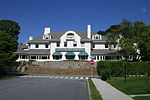Ocean Beach (New London)
Beaches of ConnecticutNew London, Connecticut

Ocean Beach Park is a large beach located on the southern shore of New London, Connecticut. It overlooks the southernmost end of the Thames River as well as the Long Island Sound, and the islands of Fisher's Island and Long Island can be seen from the beach. Ocean Beach Park contains within its boundaries a large sugar-sand beach, boardwalk, mini golf, kiddie rides, waterslides, olympic-size swimming pool, cafeteria, ice cream stand, nature trail, banquet halls, arcade, and often has live music performances during the summer season, specifically on its center boardwalk stage. Firework displays happen often during the summer, typically accompanied by a live tribute band.
Excerpt from the Wikipedia article Ocean Beach (New London) (License: CC BY-SA 3.0, Authors, Images).Ocean Beach (New London)
Shore Drive,
Geographical coordinates (GPS) Address Nearby Places Show on map
Geographical coordinates (GPS)
| Latitude | Longitude |
|---|---|
| N 41.305 ° | E -72.099722222222 ° |
Address
Shore Drive
06320
United States
Open on Google Maps










